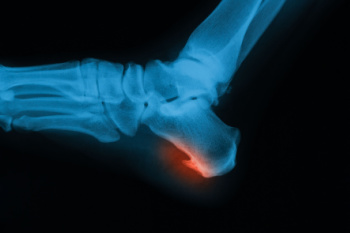 Cuboid syndrome is a foot condition where the cuboid bone, located on the outer side of the foot, becomes partially dislocated or misaligned. This misalignment causes pain and discomfort primarily felt along the lateral side of the foot, often extending to the base of the fourth and fifth toes. The peroneus longus muscle, which runs along the outer calf and attaches to the cuboid bone, plays a role in this condition. When the peroneus longus is overly tight or strained, it can pull on the cuboid bone, contributing to its misalignment. This can occur due to sudden twists or excessive weight-bearing activities. Proper diagnosis and treatment, including rest and sometimes manipulation of the cuboid bone, are essential for alleviating pain and restoring normal foot function. If you have pain in this part of your foot, it is suggested that you schedule an appointment with a podiatrist who can effectively diagnose and treat cuboid syndrome.
Cuboid syndrome is a foot condition where the cuboid bone, located on the outer side of the foot, becomes partially dislocated or misaligned. This misalignment causes pain and discomfort primarily felt along the lateral side of the foot, often extending to the base of the fourth and fifth toes. The peroneus longus muscle, which runs along the outer calf and attaches to the cuboid bone, plays a role in this condition. When the peroneus longus is overly tight or strained, it can pull on the cuboid bone, contributing to its misalignment. This can occur due to sudden twists or excessive weight-bearing activities. Proper diagnosis and treatment, including rest and sometimes manipulation of the cuboid bone, are essential for alleviating pain and restoring normal foot function. If you have pain in this part of your foot, it is suggested that you schedule an appointment with a podiatrist who can effectively diagnose and treat cuboid syndrome.
Cuboid syndrome, also known as cuboid subluxation, occurs when the joints and ligaments near the cuboid bone in the foot become torn. If you have cuboid syndrome, consult with one of our podiatrists from Mercer Ocean Podiatry. Our doctor will assess your condition and provide you with quality foot and ankle treatment.
Cuboid syndrome is a common cause of lateral foot pain, which is pain on the outside of the foot. The condition may happen suddenly due to an ankle sprain, or it may develop slowly overtime from repetitive tension through the bone and surrounding structures.
Causes
The most common causes of cuboid syndrome include:
- Injury – The most common cause of this ailment is an ankle sprain.
- Repetitive Strain – Tension placed through the peroneus longus muscle from repetitive activities such as jumping and running may cause excessive traction on the bone causing it to sublux.
- Altered Foot Biomechanics – Most people suffering from cuboid subluxation have flat feet.
Symptoms
A common symptom of cuboid syndrome is pain along the outside of the foot which can be felt in the ankle and toes. This pain may create walking difficulties and may cause those with the condition to walk with a limp.
Diagnosis
Diagnosis of cuboid syndrome is often difficult, and it is often misdiagnosed. X-rays, MRIs and CT scans often fail to properly show the cuboid subluxation. Although there isn’t a specific test used to diagnose cuboid syndrome, your podiatrist will usually check if pain is felt while pressing firmly on the cuboid bone of your foot.
Treatment
Just as the range of causes varies widely, so do treatments. Some more common treatments are ice therapy, rest, exercise, taping, and orthotics.
If you have any questions, please feel free to contact our office located in Toms River, NJ . We offer the newest diagnostic and treatment technologies for all your foot care needs.
